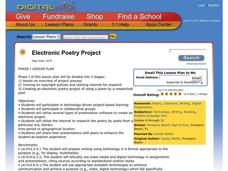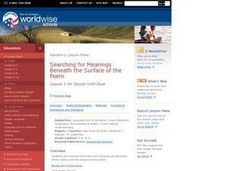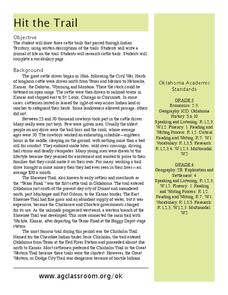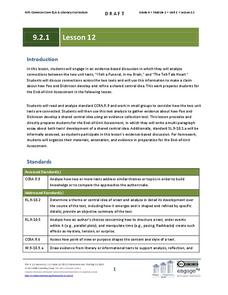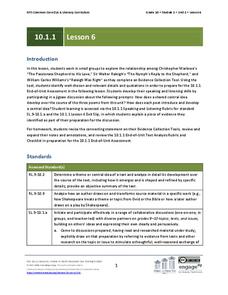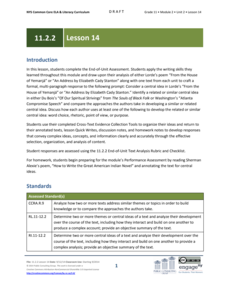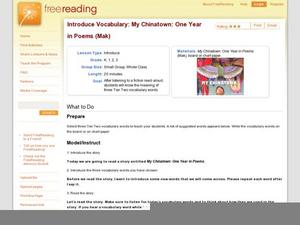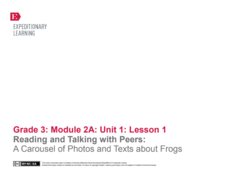Curated OER
Electronic Poetry Project
Students explore poetry. In this cross curriculum poetry and technology lesson, students choose a favorite poem and analyze its meaning. Students select several images and music to represent the poem, then create a corresponding...
Curated OER
Word Beads: Writing Poetry
Second graders write rhyming poems. In this poetry writing lesson, 2nd graders discuss the meaning of the word "funny." They use word tiles to create a rhyming poem which they transpose into their writing journals. They listen to...
Curated OER
Acrostic Poem: June
In this June worksheet, students write an acrostic poem about the month of June. Students begin each line with a word or phrase that starts with the letter on that line.
Curated OER
Searching for Meanings Benath the Surface of the Poem
Students read "Soccer Until Dusk". As a class, they discuss the various settings and actions in the poem and discuss the life in Guatemala and compare it with the United States. To end the instructional activity, they complete a...
Curated OER
Language Arts: Creative Writing Devices
Eighth graders review sound and rhythm devices and apply them to their own writing exercises. Next, they interpret the poem, "Where I'm From," as an example of a personal narrative. Using their understanding of poetic devices, they...
Curated OER
Letter Writing: An English Language Arts Lesson For Writing/Proofreading
Ninth graders write a letter to someone who is deserving of thanks. Peer and self-editing takes place. After the writing process is completed and a copy is made for the portfolio, envelopes are distributed, addressed, sealed, and mailed.
Curated OER
Poetry for the Elementary Classroom
Use Shel Silverstein's poem "Batty" to introduce poetry to young readers. This instructional activity is not formatted well, but the plan does suggest learners memorize a poem, recite the poem individually, and then recite the poem as a...
Curated OER
Hit the Trail
Students read about the history of cattle trails and complete language arts, math, social studies, and more activities about barbed wire. In this barbed wire lesson plan, students read poetry, research changes over time, draw cattle...
Curated OER
Interaction as Analysis: Emily Dickinson
Emily Dickinson’s “Hope is a thing with feathers” is the focus of a series of activities that model for learners how close reading can lead to understanding. The whole class plays with the metaphor, groups talk about the author’s...
EngageNY
Grade 9 ELA Module 2: Unit 1, Lesson 13
Whether the planks hide the beating of a hideous heart or they break away to the madness beneath, their presence makes itself known in the final instructional activity of a literary analysis unit. Having gathered textual evidence from...
EngageNY
Grade 9 ELA Module 2: Unit 1, Lesson 12
What happens when a tenuous grasp on sanity begins to slip? Compare Edgar Allan Poe's "The Tell-Tale Heart" and Emily Dickinson's "I Felt a Funeral, in my Brain" with a lesson plan focused on developing a common central idea. High...
EngageNY
Grade 10 ELA Module 1: Unit 1, Lesson 6
Wrap up your literary analysis unit with a discussion activity as tenth graders prepare for an end-of-unit assessment. After they have read and annotated Christopher Marlowe's "The Passionate Shepard to His Love," Sir Walter Raleigh's...
EngageNY
Grade 11 ELA Module 2: Unit 2, Lesson 14
It's time to put it all together! Using the resource, scholars complete an end-of-unit assessment. They write a multi-paragraph essay comparing Audre Lorde's "From the House of Yemanjá" or "An Address by Elizabeth Cady Stanton" to...
Curated OER
Introduce Vocabulary: My Chinatown: One Year in Poems (Mak)
Beautiful illustrations and tender memories of cultural identity make Kam Mak's story My Chinatown an ideal resource for budding readers learning four vocabulary words in context: fortune, scraps, soar, and victory. Introduce these...
Curated OER
Life Reflections in Songwriting and Poetry
Students analyze, discuss and compare sources of inspiration, use of words and imagery, and other differences in writing styles between two featured songwriters. This is an introductory lesson to a creative project unit.
EngageNY
Reading and Talking with Peers: A Carousel of Photos and Texts about Frogs
Frogs are the theme of a lesson plan that challenges scholars to examine photographs, read informational texts, then ask and answer questions. Scholars work collaboratelively as they rotate through stations, discuss their observations,...
EngageNY
Characters’ Decisions: The Flow of Consequences in Midsummer
Class members meet in their drama circles and share their thoughts on why it might be necessary for the audience to know something the characters don't. They read Act 3 Scene 2 of A Midsummer Night's Dream and complete consequence flow...
EngageNY
Performance Task: Performing a Narrative
Calling all performers! Scholars present a modern-day theme of adversity by performing their narratives for the class. As individuals watch their peers, they take notes on each performance using an Audience Note Sheet.
Curated OER
Creating Classroom Rules
Perfect for establishing classroom protocols, this activity gets even the youngest learners thinking about rules and their consequences. The lesson begins with a discussion and a reading of the poem Humpty Dumpty that gets youngsters...
Brigham Young University
Out of the Dust: Guided Imagery
A guided imagery exercise is a great way to get readers thinking about writing. As part of their study of Out of the Dust, Karen Hesse’s 1998 Newbery Medal winning verse novel, class members listen to a reading of one of the poems from...
Novelinks
The Little Prince: Biopoem Strategy
Learn about character traits with a biopoem activity. Based on Antoine de Saint-Exupéry's The Little Prince, the activity prompts learners to fill in the blanks of a poem form to describe themselves.
Arkansas Government
Creative Adventures with Literature - Whoever You Are
Celebrate our similarities and differences through multiple readings of Whoever you Are by Mem Fox. Readings are accompanied by a grand discussion, charts, creative art, dramatic, and music play to reinforce the uniqueness that is found...
Literacy Design Collaborative
In Pursuit of Happiness
What ideas and philosophies guided the Transcendentalist movement in America? Scholars explore the topic, reading texts by Ralph Waldo Emerson and Henry David Thoreau. Additionally, they write essays comparing the authors' structural...
Curated OER
Monsters
Do monsters really exist? Find out what your class thinks with these discussion questions prior to reading Beowulf. Incorporate music and a video clip into the anticipatory set to engage your learners. Take a day to search online for...


